The development of information society requires the reform of traditional English education. The progress of science and technology, especially the progress of Internet information technology, has penetrated into the English teaching system, reconstructed the relationship between the elements of the English teaching system, and provided technical support for the reform of English teaching. These two aspects are the internal and external impetus of English teaching reform. According to the theory of knowledge construction and multimodal information fusion, this research establishes a user-centered knowledge space, which can respond to user needs quickly, emphasizes the integration and integration of multimodal subject knowledge in resource organization, and expresses multi-dimensional relevance in functional form. The experimental results show that the optimized BOPPPS English teaching model is conducive to improving students’ participation in English classroom interaction. In the new information integration technology environment, students are more likely to put forward opinions or suggestions, and the transformation relationship of students’ interactive behavior becomes more complex.
Practice of new technologies represented by mobile Internet of Things. This is an era of knowledge economy, and knowledge has become a very important part of the productive factors [1, 2]. The subject knowledge resources embodied in English teaching activities are an important type of knowledge, characterized by high degree of specialization and scholarship.
With the development of information interaction socialization, different resource carriers and different academic exchange network environments provide a more convenient platform for knowledge providers and knowledge acquirers to communicate with each other, and the number of knowledge resources is more abundant; On the other hand, the information explosion brought about by the multimodality and big data coexistence of subject knowledge resources, and learners and English educators often feel at a loss [3]. The construction of discipline knowledge space is the first choice to solve these problems. How to effectively improve the learning effect of learners and the quality of English education for English educators? Under the new information environment, we should tap the internal relationship between subject knowledge topics and subject knowledge resources and build a multi-dimensional discipline knowledge space through multimodal information fusion technology and knowledge organization theory, Breaking the barriers of knowledge dissemination and knowledge sharing is the background of this paper [4].
For many years, China has vigorously promoted the pace of English education informatization, and now the informatization construction in the basic English education stage in China has been basically sound. At present, China’s information technology and English teaching practice are constantly integrated, the national primary and secondary school campus network and online English teaching platform are widely popularized, high-quality digital English education resources are increasingly rich, and the ability and awareness of English education managers and using information resources for English teaching have been significantly improved nationwide. The informatization construction of English education environment in China has achieved initial results, with the birth of a new term – new information fusion technology [5]. The rich technology has provided efficient support, which has changed the original English [6]. Some scholars have confirmed that teacher-student interaction has a key impact on English teaching effect, and good teacher-student interaction has a significant positive effect on improving English teaching efficiency and quality [7].
Looking back at the history of human society, each technological change has brought changes in various fields of society and created countless miracles. In human history, countless revolutionary technologies have also served the reform of English education, including three major changes [8]. Since the technology was first applied to the field of English education, researchers have paid special attention to the application and English education in English teaching and learning. The form of English education based technology are also gradual development, from open English education to remote English education, online English education, to Internet of Things English education [9]. To sum up, researchers have researched the impact on English education reform and English education on English education reform, The following issues are mainly discussed: First, the core quality and ability in the information age and the reform of Internet of Things education [10]. Second, the Internet of Things English education promotes the reform of English education. The following is a summary of the research status from these three aspects.
The people attach more importance to English learning [11]. English teaching objectives of English teaching in primary school is to encourage students to use more of what they have learned to interact with others, so as to cultivate students’ oral expression ability [12]. Good interaction can well promote students’ ability to use English and oral expression, and effectively promote the realization of English teaching goals. However, through the observation of the actual classroom English teaching [13].
Through practical investigation, we can also see that compared with the use of spoken language, students are better at mastering theoretical knowledge such as grammar and spelling [14]. The involvement of technology enriches English teaching tools, and it is bound to be accompanied by the methods. Throughout the history of the development of English teaching tools in English education in China, from the earliest chalk and blackboard to the behind PPT, projection, multimedia, and even the intervention of intelligent terminals, from the earliest simple and ordinary to the present diversified intelligence, technology is constantly updating English teaching tools and gradually enriching the English teaching environment [15].
Correspondingly, English teaching methods are also changing. English teaching in the classroom is no longer limited to teachers’ use of chalk to paint on the blackboard or to teach students the knowledge in the textbook by dictation. Teachers can use projection and multimedia equipment to present the knowledge to students in the form of pictures, animation, or video, and even let students experience the content to be taught in the textbook by themselves with the help of intelligent terminals, virtual reality and other devices [16]. These new English teaching methods due to the intervention of technology also highlight a focus in English teaching: interaction [17]. The English teaching method in English teaching theory has a hierarchical structure, which contains the meanings of a series of methods and methods of different levels and ranges.
Many relevant researchers at home and abroad have described the definition of English teaching methods in the former Soviet Union’s English education circle, which mainly includes “English teaching methods refer to the working methods of teachers and students led by teachers. With the help of these working methods, students can master knowledge, skills and techniques, form their communist world outlook and develop their cognitive ability.” I “Any English teaching method is a set of purposeful English teaching behaviors of teachers. Through these English teaching methods, teachers organize students to carry out cognitive activities and practical activities, so that students can master English teaching content and achieve English teaching objectives [18]. There are several possible definitions of English teaching methods. From the perspective of teachers’ guidance, English teaching methods can be defined as the methods of organizing students’ learning and understanding activities and controlling this activity [19]. From the perspective of emphasizing English teaching methodology, it can be defined as a method used to enable students to know from ignorance to knowledge, from incomplete and uncertain knowledge to more complete and accurate knowledge under the guidance of teachers [20]. Combining modern English education technology with English teaching, it is believed that after the combination of modern English education technology and English teaching, computers begin to transition from an auxiliary position to the English teaching stage and become an organic part of the curriculum. Traditional theories, methods, courses and textbooks have changed to theories, methods, technologies, courses and textbooks. With the integration of modern English education technology and foreign English teaching, English teaching elements have changed, and traditional English teaching elements have also been replaced by new elements [21].
It is the analysis of processes in different disciplines, the creation of new fields, the establishment of English teaching models that adapt to the constructivist learning environment, the focus on students’ main influence, the full use of students’ imagination, initiative and consciousness, and the real realization of English teaching to form correct theoretical guidance [22]. The integration of modern English education technology and English curriculum are assisted by modern English education technology based on network. How to improve the application of modern English education technology in English writing courses [23]. The teaching of English reading in the environment of modern English education technology. It proves that senior high school students can use the situation created by multimedia to learn vocabulary and master all aspects of vocabulary learning. Combined with English teaching practice. It explores the application of multimedia technology in English teaching [24]. We put forward my own views on how to improve the English teaching mode under the modern English education technology [25].
In summary, rich experimental studies have proven that good teacher-student classroom interaction and critical affective analysis have a significant effect on improving English teaching and learning, and developing students’ creativity and thinking skills. This paper expects to demonstrate that good classroom interaction can effectively meet students’ expectations of learning formats and can effectively motivate and enhance students’ motivation and interest in learning knowledge by studying that students like to participate in learning in context, prefer participatory classrooms, and expect more opportunities to show themselves and express themselves.
The key purpose of the optimization of the BOPPPS English teaching
model is to achieve a user-centered knowledge space that can quickly
respond to user needs, emphasize the integration and integration of
multimodal subject knowledge in the resource organization, and express
multi-dimensional relevant content in the form of functions. The
following algorithm formulas may be involved. BOPPPS English teaching
model is an effective curriculum design model, which is proposed by ISW,
a North American college English teaching skills training institution.
It has emerged quietly in some universities in Europe and America in
recent years. According to the rule that people’s attention can last
about 15 minutes, the BOPPPS English teaching model divides the English
teaching content of a whole lesson into several English teaching units
about 15 minutes [7]. After
receiving the pulse signal, the register will obtain the value obtained
by decreasing the detected pulse frequency, as shown in Eq.
In the practical research of English classroom teaching, although
this average weighting is widely used in practical applications, it is
not a minimum variance estimation, and auxiliary functions are
constructed, such as Eq.
Rewrite the cost function J as shown in Eq.
The data obtained in the register has the following two conditions. The process of acquiring English teaching curriculum data is shown in Figure 1.
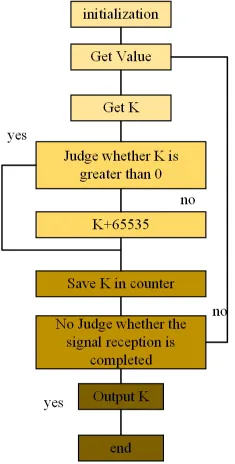
OPC server mainly has three types of objects: server, group, and item. The relationship of three layers of objects is shown in Figure [f2].

Step state prediction: estimate the state at the current time
according to the state prediction value at the previous time, as shown
in Eq.
The prediction error covariance estimates the error variance at the
current time according to the prediction value of the error variance at
the previous time, as shown in Eq.
English education turned to the study of intelligent English education and lifelong learning, and a learning society was really accepted by more and more people, as shown in Figure 3. The progress of technology is quickly reflected in the application of English education and has been committed to opening the door.
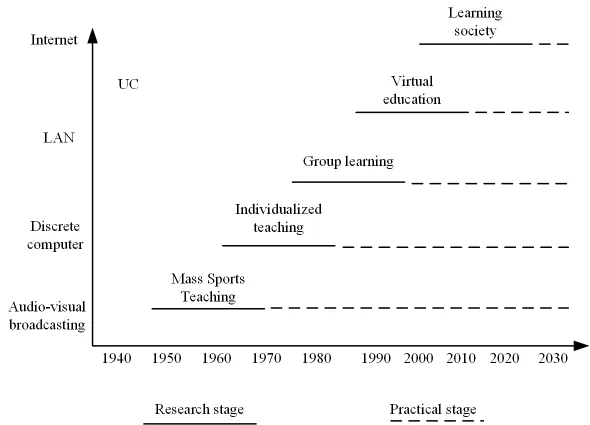
Taking “Travelling around” as an example, teachers can develop multiple micro-class videos before classroom teaching. In the micro-class video, teachers should introduce key words and relevant common phrases. For example, when explaining the word “sight”, they should not only introduce the knowledge content in the text, but also introduce common phrases such as “beinsightof” “in the sight of sb/insb’s sight”, so as to expand students’ knowledge reserves. In view of the large number of new words involved in the text, teachers do not need to expand every word to prevent too much content of micro-class videos, which will bring students preview pressure. On this basis, teachers should also develop micro-class videos about textbook content, which will not only help students deepen their understanding of the article, but also lay a foundation for their subsequent content learning. Finally, teachers should also develop the “Understanding the text” micro-class video, focusing on the analysis of long and difficult sentences, reducing the learning threshold of students, so as to achieve the teaching purpose of guiding students to discuss. In short, in the Internet environment, teachers can share the micro-class video produced, guide students to carry out targeted learning according to their own learning situation, and record their gains and problems in textbooks or notes, so as to lay the foundation for subsequent teaching activities. It is used in English education, the focus of English education theory research has changed to group cooperative learning; When the Internet of Mobile Animals entered English education, personalized English education and virtual English education appeared in theoretical research, and new concepts such as virtual classroom and virtual school appeared.
From the perspective of teacher-student interaction, the study of the main purpose is to explore the impact of new information fusion technology on classroom teacher-student interaction. For this reason, this study adopts the quasi-experimental research method to carry out research. The English teaching experiment is carried out with the abundance of technology in the environment as the independent variable and the effect of classroom teacher-student interaction as the dependent variable. Data can be called immediately after collection or saved to speed in the olf file, it is convenient to call later. The flow of the new information fusion technology is shown in Figure 4.

In the process of commenting on emotion analysis, through the sequence structure of classroom teacher-student interaction under different new information fusion technologies and summarizes the impact of new information fusion technologies on classroom teacher-student interaction. According to the results of the study, the document analyzes the advantages and disadvantages of the interaction between teachers and students in the technology classroom, puts forward effective suggestions to improve classroom English teaching within the new integrated technology information framework, and improves the quality of interaction between teachers and students. As shown in Figure 5, this study puts forward some suggestions on how to improve teacher-student interaction in the new technology information fusion classroom in the future, to provide teachers with strategic guidance in English teaching.
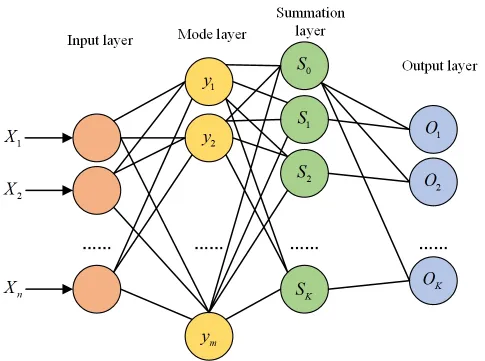
With the deep application of modern represented by computer network, the connotation of English teaching mode has begun to change. Experts in English education technology believe that English teaching mode refers to the stable relationship. The RNN neuron receives external input at each time, and receives its own output at the previous time. The output at the current time is generated through calculation. If the neuron is expanded in time, it is shown in Figure 6.
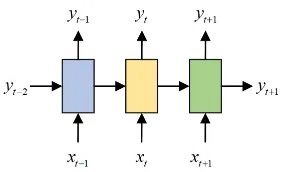
Before the experiment, researchers should first prepare for English teaching and experiment. Among them, English teaching preparation mainly includes the analysis of English teaching content, the formulation of English teaching activity plans and the production of English teaching tools; The experimental preparation mainly includes the deployment of the experimental environment, the determination of the experimental personnel and observers, and the arrangement of the experimental related equipment. English teaching experiment will be carried out after the preparation is completed. In the experiment, except for different English teaching environments, the three parallel classes were taught by the same teacher, and the English teaching content was the same. At the same time, to exclude the influence of other irrelevant factors on the experimental results, such as the entry of laboratory personnel and video recording equipment, the experiment will arrange two class hours as a pre-experiment, and the arrangement of the pre-experiment is consistent with the formal experiment. In addition to making students familiar with the experimental environment, the purpose of the pre-experiment is to check whether there are loopholes in the English teaching plan and the experimental plan and correct them in time through the pre-experiment, which can also be used to test the effectiveness of the teacher-student interaction measurement tools and improve the deficiencies according to the real data. After the pre-experiment, the formal experiment began. The experiment lasted for one unit of English teaching content, that is, three class hours. During the experiment, the video of the class was recorded as the basis. After the experiment, teachers and students were interviewed (10% of the students were randomly selected from each class), and the interview process was recorded as data to assist the analysis of teacher-student interaction. After all the experiments are completed, the data collected from the experiments, including classroom records and interviews with teachers and students, are properly stored and backed up, as well as preliminary data processing, to prepare for the later data analysis. The overall experimental architecture is shown in Figure 7.
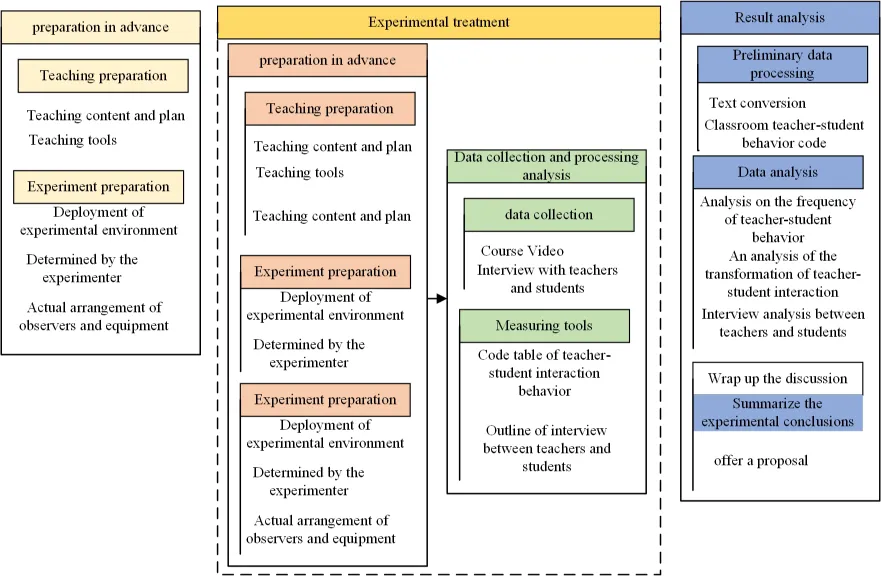
One is that the design and selection of challenging tasks must consider the difficulty of students’ completion process, leave students necessary time, and provide certain “scaffolding”, such as learning strategies, background knowledge, etc. Its purpose is to make students connect new day knowledge, vertical and horizontal knowledge, and knowledge in different fields, create cognitive conflict, and develop independent thinking and exploration spirit. The second is the authenticity of the task. The design of tasks should be close to real life, and attention should be paid to the operability of task activities, so that students can learn language skills that can be used in real life. We suggest that activity tasks should be transformed into practical problems related to students’ life, study, and subject knowledge. Third, tasks should be open. The task has a certain tension, which urges students to learn to see problems from multiple perspectives through the task.
To sum up, based on the theory of knowledge construction and multimodal information fusion, this study has established a multi-task parallel, user-centered knowledge space, which can quickly respond to user needs, emphasize the integration and integration of multimodal thematic knowledge in resource organization, and express multi-dimensional relevance in the form of functions. The next chapter will analyze the practice and empirical effect of the model.
In the key architecture of the Internet of Things, the main dimensions of teacher-student interaction are as follows: dependence, intimacy, and contradiction. Dependence refers to the psychology or tendency or behavior of students seeking help and guidance from teachers; Intimacy refers to the degree of intimacy shown in communication between psychology and behavior; Contradiction refers to the degree of harmony in interaction. It can be analyzed in detail by analyzing the performance characteristics of teachers and students in the above three dimensions.In this paper, we experiment the parameters of the real-time predictive Kalman filter to obtain the algorithm of NNKF. It is shown in Figure 8. It is divided into three parts. the BP neural network module, the GRNN module, and the Kalman filter module.
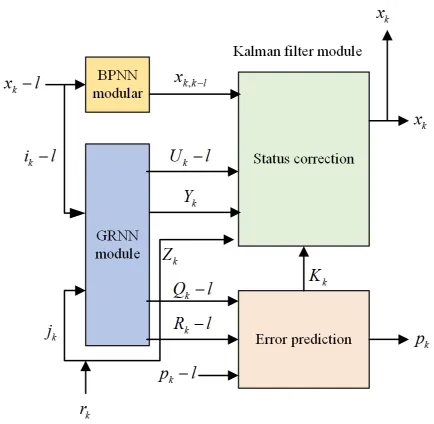
It can be seen from Figure 9 that under the intervention of multimodal information model, 66.39% of teachers think that information technology needs longer preparation time than traditional methods, 18.03% of teachers think that traditional methods and information technology need the same time to prepare courses, and 15.57% of teachers think that information technology needs longer time to prepare courses. This also challenges the adaptability of the model.

It can be seen from Figure 10 that 87.98% of students tend to use information technology in English teaching, 11.59% of students tend to have a general attitude .
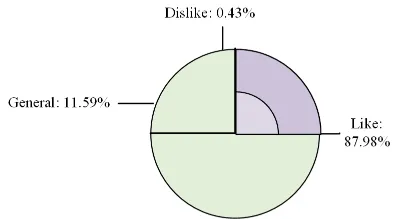
In order to prove the adaptability of the model in depth and compare it with other relevant studies, such as literature [6, 26]]. In this multimodal information model adaptability study, the recorded data of the class is 9, and the duration of each class is about 40 minutes. As shown in Table 1 below, the English teaching content recorded in the classroom is mainly divided into three categories (a complete unit of English teaching content). In order to analyze the impact of the new information fusion technology on the interaction between teachers and students in the classroom, this experiment established classroom English teaching (control group 1) under the low-technology environment, and compared and analyzed the classroom English teaching in the medium technology environment (control group 2) and the classroom teaching in the new information fusion technology (experimental group). The starting behavior is the beginning. We can explore the root of the development of teacher-student interaction through the study of the initiation behavior in three different environments. It can be seen from Table 1 that most of the interaction behaviors of the control group and the experimental group are initiated by teachers, and the teacher-student interaction behaviors initiated by students only account for about 10% of the total. Teachers play a leading role in the interaction between teachers and students in the classroom. As shown in Figure 11, the proportion of teacher-initiated and student-initiated interactions in the control group has been compared and analyzed. The proportion of student-initiated teacher-student interactions has increased (control group 1: Si=11.86%, control group 2: Si=11.94%, and experimental group Si=13.58%). It can be seen that the multimodal information model based on the knowledge map can improve students’ interactive ability to a certain extent, and improve students’ dominant position in the process of English teaching. In other words, this model has certain practical significance.
| Control group 1(D1) | Control group 2(D2) | Experience group(S) | |
|---|---|---|---|
| Teacher Start (Ti) | 88.15% | 88.07% | 86.43% |
| Student Start (Si) | 11.87% | 11.95% | 13.59% |
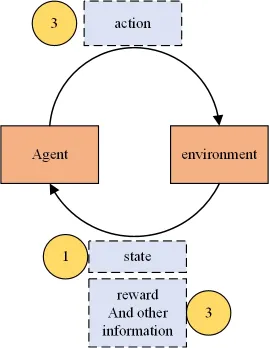
In the translation level test at the beginning and end of the semester, see Figure 12 for the sentence completion and see Figure 13 for the total scores of the pre-test and posttest, which reflects the consistency of teaching interaction and emotional analysis.
| Name |
Teachers have a
good understanding of information technology theory |
Teachers understand
information technology theory |
Teachers understand
a little information technology theory |
Teachers do not
understand information technology theory |
total |
|
P |
|
Use information
technology in each class |
12(60.01 ) | 23(38.99) | 9(24.33) | 1(16.68) | 45(36.89) | ||
|
Frequent use of
information technology |
6(30.01) | 30(50.86) | 17(45.96) | 3(50.01) | 56(45.91) | 13.23 | 0.04 |
|
Occasional use of
information technology |
2(10.01) | 6(10.18) | 11(29.74) | 2(33.34) | 21(17.22) | ||
| total | 20 | 59 | 37 | 6 | 122 |
Under the framework of knowledge construction and multimodal
information fusion theory, the teacher-student relationship in English
teaching is one-to-many. The correlation degree is calculated as shown
in Eq.
| Name |
I like information
technology in English teaching |
I generally like
information technology in English teaching |
Dislike information
technology in English teaching |
total |
|
p |
|
Information technology
can greatly improve attention |
171(83.42) | 15(55.55) | 0(0.00) | 186(79.84) | ||
|
Information technology
helps to improve attention |
33(16.11) | 12(44.45) | 0(0.00) | 45(19.32) | 128.31 | 0.00 |
|
Information technology
does not help improve attention |
1(0.48) | 0(0.00) | 1(100.00) | 2(0.87) | ||
| total | 205 | 27 | 1 | 233 |
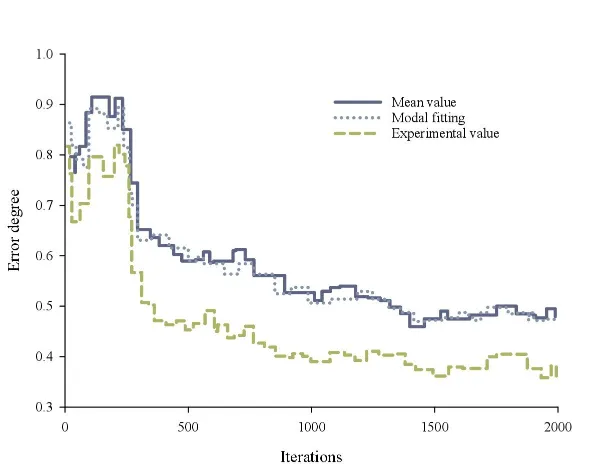
Secondly, in the empirical process of the model, teachers should
flexibly use new information fusion technology to analyze and answer
English knowledge, and make full use of students’ interest in English to
transfer. The test results are shown in the sentence completion
situation shown in Figure 13. The total score before and after the
test is shown in Figure 14, which reflects the consistency of
teaching interaction and emotional analysis. The correlation ratio
between teaching interaction and environment can reach 87% calculated by
Eqs.
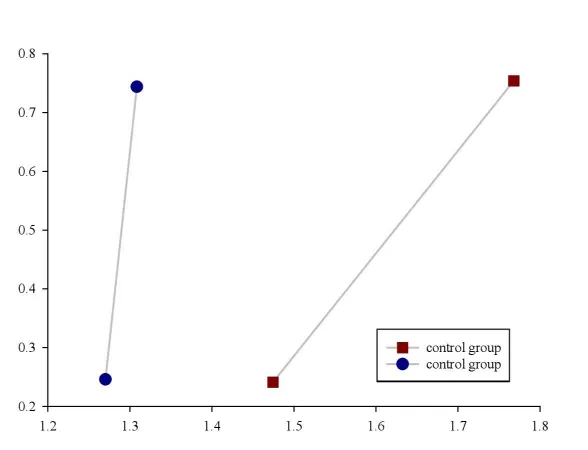
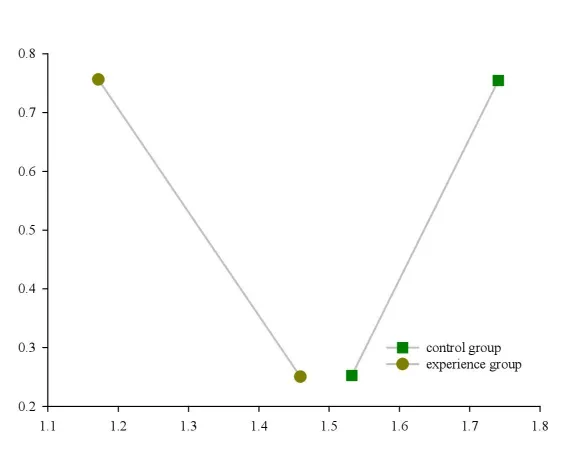
According to the optimization of effective teaching strategies in the current English classroom, in the future English teaching, the following measures can be considered to improve English teaching and better improve students’ comprehensive English level: classroom teaching strategies that make rational use of vocabulary and grammar. The teacher classifies the vocabulary of the textbook in advance and guides students to use different strategies to remember different types of words; The teaching strategy time of English input and output should be allocated reasonably; Appropriately increase the training of translation skills.
According to the theory of knowledge construction and multimodal information fusion, this study has established a user-centered knowledge space, which can quickly respond to user needs, emphasize the integration and integration of multimodal thematic knowledge in resource organization, and express multi-dimensional relevance in the form of functions. The experimental results show that the model reflects the consistency of teaching interaction and emotional analysis, and the correlation ratio between teaching interaction and environment can reach 87%. At the same time, there are some limitations in this study. First, due to the registration of objective conditions, the number of interviews and questionnaires is still not enough. Secondly, the author was unable to observe the actual classroom teaching, so due to the impact of COVID-19, there was a lack of classroom observation in the study. Last but not least, due to the limitations of experience and ability, there are still some deficiencies in questionnaire analysis and interviews.
This work was supported by the Jiangxi Provincial Education Science “The Thirteenth Five-year” Planning Subject: 19ZD111, Research on Construction Strategies of Ecological College English Classrooms in the Era of Big Data.
The author declares no conflict of interests.
1970-2025 CP (Manitoba, Canada) unless otherwise stated.